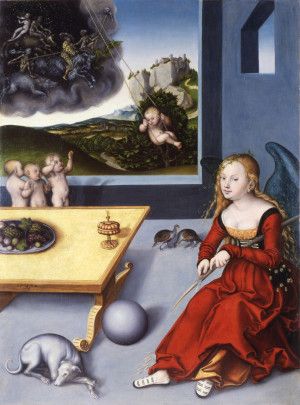Oeuvre : Précisions - La Mélancolie | Musée Unterlinden |



Aller plus loin :
Auteur :
Précisions concernant l'auteur :
Cranach, 1472 ; Weimar, 1553
Titre :
Technique et matériaux :
Millésime de l'oeuvre :
1532 achevé en
Commentaire :
L’œuvre est une réinterprétation de la gravure “Melancolia I” d’Albrecht Dürer (1514). Dans cette dernière, le graveur faisait l’apologie de la mélancolie, propice à la créativité artistique. Cranach, proche des idées de Luther, condamne ce tempérament et préconise les nourritures terrestres pour s’en préserver.
Parmi les acquisitions les plus marquantes du musée, La Mélancolie, achetée à l’initiative du conservateur Christian Heck, occupe une place de choix. Auparavant conservée dans des collections particulières suédoises, l’œuvre intègre en 1983 la collection du musée.
Das Gemälde ist eine Neuinterpretation von Dürers Stich „Melancolia I“ (1514). Dürer verherrlicht in seinem Stich die Melancholie, welche die schöpferische Kraft des Künstlers beflügelt. Cranach, der den Ideen Luthers nahe stand, verurteilt dieses Temperament und empfiehlt die irdischen Gaben, um sich vor ihm zu schützen.
Unter den bedeutenden Erwerbungen des Musée Unterlinden nimmt die Melancholie von Lucas Cranach dem Älteren eine herausragende Stellung ein. 1983 wird die Grafik auf Initiative des Konservators Christian Heck aus einer schwedischen Privatsammlung für das Museum erworben und nimmt ihren Platz neben der Melencolia I von Albrecht Dürer ein, die ihr einst als Inspiration diente.
The painting is a reinterpretation of Albrecht Dürer’s print “Melancolia I” (1514), in which he extolled the virtues of melancholy as a temperament conducive to artistic creativity. Cranach, who was a follower of Luther’s ideas, condemns melancholy and advocates earthly nourishment to keep it at bay.
Amongst the museum’s most noteworthy acquisitions, Melancholy, bought at the instigation of curator Christian Heck, occupies a prime position. Previously held in Swedish private collections, it joined the museum’s collection in 1983, bringing it together with Albrecht Dürer’s engraving Melencolia I, which provided the inspiration for the painting.
Parmi les acquisitions les plus marquantes du musée, La Mélancolie, achetée à l’initiative du conservateur Christian Heck, occupe une place de choix. Auparavant conservée dans des collections particulières suédoises, l’œuvre intègre en 1983 la collection du musée.
Das Gemälde ist eine Neuinterpretation von Dürers Stich „Melancolia I“ (1514). Dürer verherrlicht in seinem Stich die Melancholie, welche die schöpferische Kraft des Künstlers beflügelt. Cranach, der den Ideen Luthers nahe stand, verurteilt dieses Temperament und empfiehlt die irdischen Gaben, um sich vor ihm zu schützen.
Unter den bedeutenden Erwerbungen des Musée Unterlinden nimmt die Melancholie von Lucas Cranach dem Älteren eine herausragende Stellung ein. 1983 wird die Grafik auf Initiative des Konservators Christian Heck aus einer schwedischen Privatsammlung für das Museum erworben und nimmt ihren Platz neben der Melencolia I von Albrecht Dürer ein, die ihr einst als Inspiration diente.
The painting is a reinterpretation of Albrecht Dürer’s print “Melancolia I” (1514), in which he extolled the virtues of melancholy as a temperament conducive to artistic creativity. Cranach, who was a follower of Luther’s ideas, condemns melancholy and advocates earthly nourishment to keep it at bay.
Amongst the museum’s most noteworthy acquisitions, Melancholy, bought at the instigation of curator Christian Heck, occupies a prime position. Previously held in Swedish private collections, it joined the museum’s collection in 1983, bringing it together with Albrecht Dürer’s engraving Melencolia I, which provided the inspiration for the painting.


 Copyright© WebMuseo 2019 - 2024
Copyright© WebMuseo 2019 - 2024